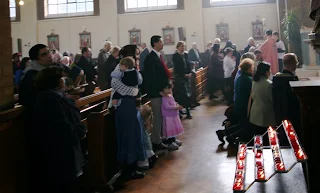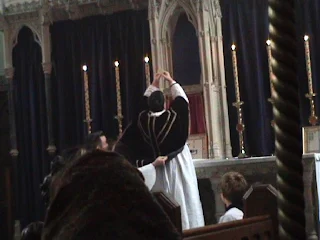This post focuses on two recent events which I attended, where Mass was celebrated by Fr Andrew Southwell.
First, back on Laetare Sunday I attended the regular Traditional Mass at St Bede's, Clapham Park, London. Fr Andrew Southwell, who has been resident here and assisting the Parish Priest, Fr Christopher Basden, for eight years, celebrates a Traditional (usus antiquior) Sung Mass every Sunday here at 10.45am. I am pretty sure that this is the only regular sung Mass of its kind in the UK. Usually these are Gregorian Chant, with a locally recruited schola, but once a month Charles Finch and the Cantores Missae sing a polyphonic setting. These singers are worth hearing, so (with permission) I have got a short video clip for NLM readers. Here they are singing Missa Quam pulchri sunt by Tomas Luis de Victoria. Again, as something which happens every month, singing of this quality at the Traditional Mass is unique in the UK, and
 It is worth noting that St Bede's is a very diverse community, which includes many recent immigrants. Absurd as it is, on historical grounds, the claim that the Traditional Mass appeals only highly educated middle-class sophisticates continues to be made, and St Bede's is a living counter example. St Bede's is doing with the traditional liturgy today what the liturgy has always done, which is to appeal to both intellect and emotion simultaneously, to the educated and the uneducated, to the old and to the very young. Certainly, since my videos of the Mass have been on my computer desktop, they have proved a great favourite for my four-year-old daughter, who has worked out how to activate them...The following weekend, I saw Fr Southwell again at St Edmund's College, Ware, for a meeting of the
It is worth noting that St Bede's is a very diverse community, which includes many recent immigrants. Absurd as it is, on historical grounds, the claim that the Traditional Mass appeals only highly educated middle-class sophisticates continues to be made, and St Bede's is a living counter example. St Bede's is doing with the traditional liturgy today what the liturgy has always done, which is to appeal to both intellect and emotion simultaneously, to the educated and the uneducated, to the old and to the very young. Certainly, since my videos of the Mass have been on my computer desktop, they have proved a great favourite for my four-year-old daughter, who has worked out how to activate them...The following weekend, I saw Fr Southwell again at St Edmund's College, Ware, for a meeting of the Traditional Catholic Family Alliance. St Edmund's claims to be the oldest Catholic school in the country, as the continuation of Cardinal Allen's 1568 foundation at Douai. It arrived in England, like many English Catholic institutions (such as the monasteries of Ampleforth and Downside) when the French Revolution made continued life on the Continent impossible. Arriving in 1793, it could benefit from the Catholic Relief Act of 1778; until then Catholic schools and churches were at least theoretically impossible. One of the most remarkable things
Traditional Catholic Family Alliance. St Edmund's claims to be the oldest Catholic school in the country, as the continuation of Cardinal Allen's 1568 foundation at Douai. It arrived in England, like many English Catholic institutions (such as the monasteries of Ampleforth and Downside) when the French Revolution made continued life on the Continent impossible. Arriving in 1793, it could benefit from the Catholic Relief Act of 1778; until then Catholic schools and churches were at least theoretically impossible. One of the most remarkable things about it for the visitor today is the great Pugin chapel.
about it for the visitor today is the great Pugin chapel.It is not easy to give an impression of the chapel. But here is the altar (without the temporary altar which usually sits in front of it), the impressive stained glass window above it, the beautiful ceiling, and the rood screen with its rood. There is so much going on here, with lovely side chapels, nave altars and so on. The brightly coloured triptych below is in the Gallillee Chapel, which is where the families eat their lunch after Mass.
 This chapel, classrooms and other parts of the school are very kindly made available to the Traditional Catholic Family Alliance for their monthly meetings. As a chaplain to available to the the TCFA, Fr Southwell celebrates a missa cantata and teaches catechism to a succession of age-groups, while other children, and the adults, engage in a range of activities and talks. This has been going now for a number of years, and there is another TCFA group which meets in Reading.
This chapel, classrooms and other parts of the school are very kindly made available to the Traditional Catholic Family Alliance for their monthly meetings. As a chaplain to available to the the TCFA, Fr Southwell celebrates a missa cantata and teaches catechism to a succession of age-groups, while other children, and the adults, engage in a range of activities and talks. This has been going now for a number of years, and there is another TCFA group which meets in Reading.The Church's liturgical tradition continues to bring forth its fruits. What is particularly evident in the apostolate of Fr Southwell is the strength it gives to families to live out the faith. We are
 fortunate to have Mr Finch singing for us in St Bede's, and Mr Pugin providing the backdrop of the Family Day in Ware, and as these are examples of the Tradition's artisitic expression at its best, this is appropriate. But these sorts of events can and do also take place in less auspicious conditions: where there is nothing but the Low Mass and a good will, there also the Holy Ghost has His effect.
fortunate to have Mr Finch singing for us in St Bede's, and Mr Pugin providing the backdrop of the Family Day in Ware, and as these are examples of the Tradition's artisitic expression at its best, this is appropriate. But these sorts of events can and do also take place in less auspicious conditions: where there is nothing but the Low Mass and a good will, there also the Holy Ghost has His effect.Cardinal Hoyos spoke with great insight when he said, of those attached to the Traditional liturgy,
 in a 2004 interview: 'In reality, what we frequently find is a Christian view of the life of faith and of devotion - shared by so many Catholic families that frequently are enriched by many children - that has special characteristics, and we can mention as examples: a strong sense of belonging to the Mystical Body of Christ, a desire to maintain strong links with the past - that wishes to be seen, not in contrast with the present, but in a line of continuity with the Church - to present the principal teachings of the Faith, a profound desire for spirituality and the sacred etc..'
in a 2004 interview: 'In reality, what we frequently find is a Christian view of the life of faith and of devotion - shared by so many Catholic families that frequently are enriched by many children - that has special characteristics, and we can mention as examples: a strong sense of belonging to the Mystical Body of Christ, a desire to maintain strong links with the past - that wishes to be seen, not in contrast with the present, but in a line of continuity with the Church - to present the principal teachings of the Faith, a profound desire for spirituality and the sacred etc..'

